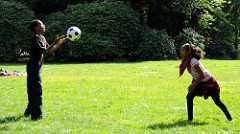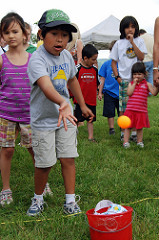Main Content
Lesson 1: Overview of Autism Spectrum Disorders
Characteristics of Autism Spectrum Disorders
“Universities are renowned for their tolerance of unusual characters, especially if they show originality and dedication to their research. I have often made the comment that not only are universities a 'cathedral' for worship of knowledge, they are also 'sheltered workshops' for the socially challenged.”
– Tony Attwood, The Complete Guide to Asperger's Syndrome
Language Deficits

Not all children with ASD will display language deficits. Ability to communicate will vary by age and by individual. Some children with ASD may not be able to speak, while others may have rich vocabularies and be able to talk about specific subjects in great detail. Some children with ASD may display echolalia, in which they repeat words or phrases rather than engage in typical conversation. Echolalia can be immediate or delayed. An example of immediate echolalia would be when I say, "Good morning," and you say, "Good morning." I say, "How are you?" and you say, "How are you?" With delayed echolalia, the child can verbatim state a phrase that occurred some time ago. Some children can watch a movie (seems like it’s often Disney!) and can give you the entire script a few hours or even days later.
Additionally, the individual with ASD may have limited or delayed speech, such as single-word utterances or approximations of words. For example, instead of saying “ball,” the child says “ba.” The limited or delayed speech might mean that the individual with ASD has adequate speech, but difficulty with forms of language. His or her prepositions might be off; pronouns might be different. You might also see individuals with ASD who have no functional speech. They might be using other forms of communication, such as augmentative and alternative communication (AAC). For example, they might be using sign, a communication board with pictures, or a voice-output electronic system for communication.
"I can’t wrap my head around this."
"A penny for your thoughts."
"The ball is in your court."
"Costs an arm and a leg!"
"burning the midnight oil"
Some individuals might have problems with what we call pragmatics, meaning that they might not understand the social norms related to language. One common issue is misunderstanding sarcasm (as in, "Oh sure, I’d love to do that…"). Individuals with ASD may also use language in unusual ways, such as inappropriately using formal words, describing things in odd ways, having difficulty in conversation, or lecturing in a formal tone during informal discussions.
One common language deficit is the inability to comprehend idioms. As you know, idioms are expressions or figures of speech that aren’t to be taken literally. If you’ve ever interacted with someone from a different country, you know that idioms often differ from country to country. Idioms can be very difficult for individuals with ASD to understand; they might think it’s literally raining cats and dogs!
Individuals with ASD can also have difficulty understanding nonverbal communication, facial expressions, gestures, and/or proximity. For example, individuals with ASD might not interpret someone stepping back as a sign they're standing too close. They might also present with a very flat affect. For example, they might not display facial expressions in response to someone who's telling a very animated story. We don’t always think of nonverbal communication, but it is very important in conveying a message. Lastly, individuals with ASD might have difficulty processing language in distracting environments, such as a noisy environment or an environment with a lot of stimuli (like a cafeteria or a loud mall).
Now that you have read about the language deficits related to ASD, watch the following videos to get an idea of what these language deficits might look like in action.
Delayed Echolalia
In the first video, you will see an example of delayed echolalia. This young man is using what we call scripted dialogue. He's very interested in Tigger from Winnie the Pooh and uses exact lines from the movie. You’ll see that he's trying to get his mom involved in the dialogue because he wants her to recite the phrases with him.
Augmentative/Alternative Communication (AAC)
In this clip, you will see a boy named Timmy using augmentative/alternative communication (AAC). He's touching a screen that has a symbol on it. Once the symbol is pressed, there is voice output. Timmy has some behavior problems, but his communication device serves to decrease the inappropriate behaviors by allowing him to communicate more effectively.
Picture Exchange Communication System (PECS)
In this clip, you will see Andy, who is 10 years old and has cerebral palsy and ASD. He is nonverbal and uses AAC. He is learning how to use a picture exchange communication system (PECS) to communicate with people who do not know sign language. When using a PECS, he selects the picture icons, places them on the strip at the bottom of the binder, pulls off the message, and hands it to the person to indicate what he or she wants/needs.
Social Differences

Next, your text discusses social differences related to ASD. Individuals with ASD may have deficits in what has been called theory of mind. This is sometimes referred to as mind blindness. Mind blindness is the inability of the individual to take the perspective of someone else. Much like the Greek word auto, which means being involved in oneself, individuals with ASD might not understand what others are thinking or perceiving or that their perceptions might differ from others'. For example, if they're frustrated with something, they assume that everyone else is frustrated with it as well. If they are okay with things, they assume everyone else is as well.
Joint Attention
Along with deficits in theory of mind are deficits in joint attention. Joint attention is the ability to share an experience. For example, as you watch TV, you say to your friend across the room, “Oh my gosh, that's funny—look at that!” You look at the other person; they look and are laughing too. You have just jointly shared in an experience.
Below is a video segment related to joint attention. This is a wonderful experiment that highlights the concept of joint attention. The researcher has three groups of children: individuals who are neurotypical, individuals who have intellectual disabilities (ID), and individuals who have ASD. The researchers are testing the children's reactions to various situations, such as someone getting hurt or being scared. As you'll see, the individuals with ASD don't always pay attention to others, don't always look or share the experience, and don't always understand others' points of view. It's really intriguing in this clip to watch the child with the ID. At one point, he just gets up and fixes the problem for the group, saying, "All gone." I like the way he thinks!
There also may be deficits or differences in the play of children with ASD. For example, you might observe more instances of parallel play (side by side but not together). Typically, developing young children will engage in parallel play, but eventually they'll move to cooperative play, in which they engage with each other. You see less cooperative play in children with ASD. This, of course, goes hand in hand with the issues of joint attention just discussed. There is a lot less sharing of experiences with others.
Individuals with ASD can also display social differences that are quite subtle in nature. For example, a common issue is that of personal space, with people with ASD often standing too close to another person. A good example of this can be seen in the Seinfeld episode about the “close talker.” If you stand too close to someone's face when they're talking, it can be very disconcerting. They might step back as a natural reaction. The person with ASD, though, will sometimes step up a little bit more; he or she might not understand the parameters of personal space.
Also, individuals with ASD often lack eye contact; they might not look at you when you speak. This can also be very disconcerting. Of course, lack of eye contact varies with culture, but, in the United States, not looking someone in the eyes while he or she is speaking can make you appear untruthful or uninterested in what is being said. Additionally, some individuals with ASD may appear uninterested or self-centered, wanting to talk only about their topic of choice. Another social difference is the inability to start a conversation or maintain it. For example, if you say, “How are you?” most people will say, “Fine.” You might continue and say, “What did you do last night?” Typically, the person you ask will detail the night’s activities. If you're engaging with a person with ASD, though, the conversation may just stop. The person with ASD may be unable to maintain an ongoing conversation or to engage in the typical back-and-forth exchange we have when we talk with others.
Repetitive Behaviors and Restricted Interests
Another diagnostic criterion of ASD is repetitive behaviors and restricted interests. We’ve already discussed that "individuals with ASD" is a very heterogeneous group. This heterogeneity can be manifested in the type of repetitive behaviors and restricted interests that are evidenced. Repetitive behaviors are those that are repeated over time. Some individuals with ASD engage in the self-stimulatory (sometimes called stereotypical) and repetitive behaviors of rocking and hand-flapping. You might work with a child who has the self-stimulatory behavior of tugging on the bottom of his shirt and making a noise each time. Below is a video of a child engaging in such stereotypic behavior.
There can also be an insistence on sameness. Some individuals with ASD really dislike changes in routine. If a particular person is absent one day at school, the child may have a great deal of difficulty coping that day. If gym class is cancelled due to weather, the child might display behavioral problems due to difficulties with the change in routine.
Self-Injurious Behavior (SIB)
Individuals with ASD also may engage in self-injurious behavior (SIB) or aggression. Self-injurious behavior can range from mild to quite severe. Some individuals with ASD may bite their hands; some may hit their heads. Others may have extreme SIB, such as gouging their eyes and causing blindness or gouging their ears and causing hearing problems. Extreme instances of SIB can be very difficult to handle and require immediate attention if they are life-threatening. Individuals with ASD might also engage in physical aggression toward others (e.g., kicking, hitting, or scratching) or display verbal aggression (talking back or using profanity).
Below, you will see an example of a young man who displays self-injurious behavior. You'll notice that he's wearing a helmet. He may be wearing the helmet due to seizures or for protection from his head-hitting. He wears headphones to cut down on noise, and you'll see him chewing on some rubber tubing, probably to keep him from grinding his teeth. His self-injurious behaviors are head-hitting, biting, and slapping his legs. His family has put up several videos; you will probably be able to tell that they're very frustrated, feeling that they need a lot more support in the home. This is a more extreme instance of SIB that shows that life at home may be very difficult and that additional support for the family may be needed.
Savant Skills
A relatively small portion of individuals with ASD may display savant skills. You might also hear this referred to as "splinter skills" or "islands of genius," wherein the individual can be quite low-functioning in some areas of development, but can have great abilities in others. Savant skills typically occur in areas like music, art, or mathematics. You can see an example of savant skills in the movie Rain Man, where Raymond, who has ASD, has difficulty with functional skills but great mathematical and memorization abilities. Savant skills are often portrayed in popular media, so many think this is how individuals with ASD function; however, the condition is not very common. Savant skills occur only in about 1% of individuals with ASD.
Below is a fascinating clip of a man named Stephen Wiltshire, who has savant skills. He’s sometimes called “the living camera.” He didn't talk until the age of five, but at age 11 he began drawing very complex scenes from memory. In this clip, researchers took Stephen to Rome, gave him a 45-minute helicopter ride over the city, and then asked him to draw the city. The level of accuracy and detail is phenomenal. Again, remember that savant skills are not commonly evidenced in individuals with ASD—but they are fascinating!
Also, subsumed under the category of repetitive behaviors and restricted interests are individuals with ASD who have very set routines, compulsions, or rituals. For example, before they are able to leave the house, they might need to do certain things each time (check the stove, touch the light switch, turn the knob three times, etc.). These individuals are also going to have difficulty with change. They might have trouble problem-solving if the situation is unfamiliar. For example, if someone has the day off of work and an individual with ASD is now responsible for picking up the colleague’s part of the job for the day, it may be difficult for him or her to adjust.
Motor Deficits

Individuals with ASD often have what is called dyspraxia, or difficulty with motor planning. Some individuals may have balance issues or awkward movements, may walk on their toes, or may have delayed developmental milestones. Motor issues can be categorized based on the fine motor skills or the gross motor skills. Fine motor skills center on small muscle movements—things like buttoning a shirt or getting the cap off of a tube of toothpaste. Gross motor skills involve large muscle groups, typically dealing with ambulation (walking) and being able to move one’s arms in a wide circle.
Gross Motor Skills
Motor issues are addressed through occupational therapy (OT) or physical therapy (PT). Occupational therapists often work with children with ASD on handwriting issues, helping them hold the pencil or pen correctly and helping them learn the amount of pressure to use when putting the pen to paper. Physical therapists may help individuals with ASD walk properly. Below, you will see a video of a child engaging in toe-walking, a gross motor skill.
